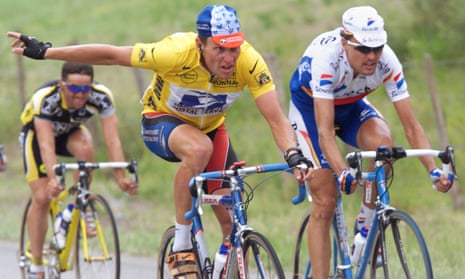The foie gras, strawberries and red wine have long been cleared away and in a deserted press tent in Albi, Michael Rasmussen is talking about the time he was kicked off the 2007 Tour de France with victory in Paris in sight. In a new book, The Yellow Jersey, Rasmussen describes the humiliation and desperation of fleeing that Tour under cover of darkness after his lies over his anti-doping whereabouts status caught up with him.
Bundled into a rental car at midnight by his team boss, only hours after celebrating victory in the yellow jersey on the Col d’Aubisque, he was left alone in a remote bed and breakfast at the foot of the Pyrenees, where he contemplated suicide. “I walked around and looked for some way to hang myself,” the Dane recalled. “If I’d had a gun I would have shot myself. It was almost unbelievable what they did to me considering all that I had done for them.”
“They” were his sponsor Rabobank, a team who later imploded under the weight of serial scandals. “The sport didn’t become any cleaner that day,” he says as warm evening sun floods the room. “In fact, it became more dirty. What happened to me was more about brands and marketing and saving reputations.”
On Friday the Tour returns to Pau, the scene of Rasmussen’s nocturnal humiliation, for this year’s pivotal individual time trial. The city at the foot of the Pyrenees has been on a doping ley line, a focal point for scandal, for almost two decades.
Before Rasmussen it was the Tour’s bete noire, Lance Armstrong, who faced down his accusers in 2001 in a press conference room in Pau’s Palais Beaumont, denying all allegations and scoffing at the suggestion his success was fuelled by doping. When the Tour paused in Pau in 2007, the Kazakh rider Alexander Vinokourov quit in disgrace after testing positive for blood doping, only a couple of days after an unexpected time-trial victory had been hailed by L’Equipe as “Le Courage de Vino”.
There is a long list of doping scandals centred on Pau. In 2012 Fränk Schleck left the Tour there after a positive test, while Juan José Cobo, winner in the 2008 Tour’s stage from Pau to Hautacam, was on Thursday stripped of his own overall victory in the 2011 Vuelta a España, in favour of Chris Froome. But 20 years after Armstrong’s first win, where does cycling stand now? Rasmussen is not alone in his continuing scepticism. “As long as there’s the possibility to get an advantage, somebody will be doing it, and the possibilities are there.”
In July 1999, when Armstrong took the first of his seven Tour titles, a French rider called Christophe Bassons raised his voice in protest, one of the few to be heard in a submissive peloton. The Texan, riled by Bassons’ outspokenness, rounded on him, telling him to shut his mouth or go home.
“The omertà still exists in cycling,” Bassons, who now works in anti-doping in the Nouvelle Aquitaine region, says. “Nobody wants to speak out but that’s normal. They all have their secrets and most of the riders hope to move to working for TV or radio or driving a VIP guest car when they retire. I don’t think things have changed that much. The will to cheat is still present, it’s just harder to pull it off than before.”
Rasmussen admits that anti-doping in cycling is still lagging behind where it needs to be. “I do believe that things are better but not that doping has gone away. It’s not in the nature of sport. When you know that you have more Olympic medals won by asthmatics, it shows, it would be nice to think healthy people can beat sick people, but that’s not the case at the Olympic Games.”

Despite that, Bassons, bullied out of the 1999 Tour by Armstrong and seen as damaged goods for the rest of his racing career, insists he is optimistic.
“People often focus on what doesn’t work, rather than what does work. Anti-doping controls and the work by the police and customs limits the spread of doping. If that wasn’t in place there’d be a lot more doping.
“As for the governing bodies, I’m not always sure they are motivated to fight doping. Some want to preserve their positions and prefer to look the other way. We will only be really able to fight doping when we change that way of thinking.”
Yet Rasmussen is not alone in thinking that Armstrong’s lifetime suspension was a judgment on him as a human being, rather than as an athlete.
“You can’t do that just because you think he’s a bastard. There are no rules in cycling against that, in fact, the bastards are the ones that win.
“The problem is the hypocrisy. His teammates got six months’ suspension for doing the same thing in the same team, in the same team bus, yet he got a lifetime suspension.”
While Bassons has turned his back on the sport, watching the Tour only occasionally out of “professional interest”, Rasmussen is working on this year’s race for the Danish media. “I love cycling and, if you love cycling, this is the place to be.
“I was eight years old when I told my local newspaper that I wanted to ride the Tour de France. I’d been pursuing that for 25 years but I know that I will always be better known for what I didn’t win than for what I won. It’s something that I will take to my grave, a wound that won’t ever heal.”
The Yellow Jersey by Peter Cossins, is published by Yellow Jersey Press
